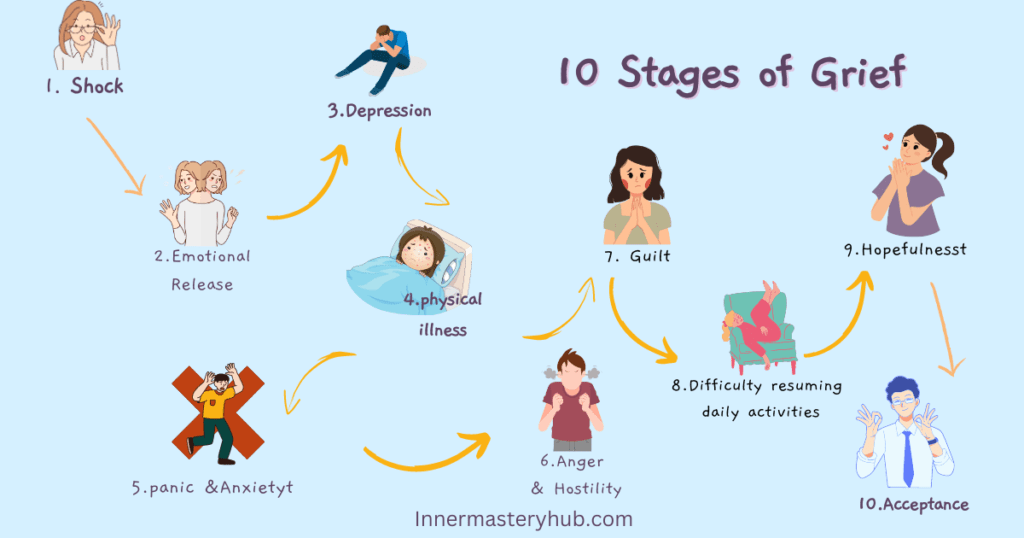10 Stages of Grief & Strategies for Healing

Grief can be so overwhelming that it feels like you’re adrift. Everybody has a different experience with it, and the feelings can be pretty complex. Nevertheless, knowing the phases of grief can be comforting and helpful. Consider them a sort of roadmap helping us understand the healing process.
This essay will examine grief from multiple perspectives. We will discuss the expanded seven-stage model, the ten-step approach, and the well-known five phases of grief introduced by psychiatrist Elisabeth Kübler-Ross.
These 10 stages of grief don’t always occur sequentially or follow a predetermined course. Instead, they provide a structure that enables us to deal with loss more mindfully.
The five stages of grief
The Kübler-Ross model is the name of her grief theory. These phases of grief have been adapted for other types of loss, even though they were initially developed for individuals with serious illnesses. Here are the steps to follow to process the pain:
Denial
A sense of denial is the initial step of grief, where you refuse to accept the reality of loss. This defense mechanism temporarily relieves the pain, manifesting as a state of disbelief and numbness. It’s a natural reaction that helps you to cushion the immediate shock when dealing with a loss.
Anger
Anger, the next stage, is a raw emotional response to loss. It presents as frustration directed at yourself or around others, a rebellion against the unfairness of the situation, or resentment towards the pain caused by the loss.
Bargaining
Bargaining, another phase, is marked by attempts to negotiate or make deals with a higher power, in a desperate search to escape or reverse the loss. It reflects your struggle to find meaning and regain control in isolation, as well as the overall feeling of loneliness.
Depression
Deep sadness and hopelessness are hallmarks of depression. It’s an emotional decline into hopelessness characterized by intense emotions of emptiness, disinterest, and retreat from the outside world.
Acceptance
The last step, acceptance, is the slow recognition and comprehension that life must continue despite the loss. Learning to cope with loss, discovering a new purpose, and moving forward with fortitude and hope are more important than forgetting or letting go of the past.
10 Stages of Grief
Stage 1: Shock
Shock is an immediate reaction to sudden traumatic events, characterized by feelings of disbelief, numbness, and a disconnection from reality. Here are some real-life examples of shock:
- In isolation after a sudden and unexpected death, a person feels numb and unable to comprehend the truth of the loss, refusing to believe the news even if reliable sources confirm it.
- If you have been in a serious auto accident, you may experience shock, uncertainty, disorientation, and difficulty comprehending what has just occurred.
- You may experience shock after an unexpected job loss, finding it challenging to comprehend reality and feeling as though you are in a dream state.
Stage 2: Emotional Release
The process of releasing bottled-up and suppressed emotions with relief, clarity, and lightness is known as emotional release. This phase of the grieving process is a typical part of the process.
- After losing a parent, a lady who has been suppressing her grief may finally find release in counseling, shedding tears and letting her feelings be spoken.
- A man who is stressed out at work can find that a strenuous workout helps him release his emotions. He will feel relieved after working out hard.
- A person may eventually face a friend and openly express their sentiments after suppressing anger and animosity toward them for a perceived slight. This can result in a feeling of freedom.
Stage 3: Depression and Isolation
People retreat from social interactions and connections during the depression and isolation phase of the grieving process, and they may also suffer ongoing melancholy, hopelessness, or a lack of interest in things they used to like.
When a partner passes away, a person may stop engaging in hobbies, spend more time alone, and become disinterested in things that once brought them happiness.
A person with a chronic illness may show symptoms of depression, including low energy, a diminished desire to socialize, and ongoing melancholy.
One may withdraw from friends after a breakup, lose interest in going out or making new friends, and cry or feel depressed for a long time.
Stage 4: Physical Illness
Diseases or illnesses that affect the physical body are referred to as physical ailments, and they are frequently characterized by symptoms such as organ dysfunction, fatigue, and pain. Here are a few actual cases of persons exhibiting bodily signs of distress:
Cardiovascular illness, which can impact a middle-aged man’s everyday activities and quality of life, is characterized by chest pain, dyspnea, and frequent exhaustion.
A young lady may experience severe headaches, light sensitivity, and nausea due to persistent migraines, which may cause her to miss work or school frequently.
Chronic joint pain and stiffness associated with arthritis can significantly impede an older adult’s mobility and ability to perform everyday tasks independently.

Stage 5: Panic and anxiety
Extreme fear and discomfort are signs of panic and anxiety, which frequently accompany stressful or dangerous circumstances.
A person may experience severe anxiety over their performance before a big presentation or public speaking event, which can cause them to sweat excessively, feel their heart race, and find it hard to concentrate on anything else.
When someone moves to a new city, they are often anxious and restless because they fear they won’t fit in or find their place.
You may experience severe anxiety about driving again after a traumatic occurrence, like a car accident, with panic attacks occurring at the mere notion.
Stage 6: Anger and Hostility
Extremely negative emotions like anger and hostility can surface at times of stress or conflict. They are frequently typified by hostile attitudes, irritability, and a willingness to fight or dispute.
Employees who work in a stressful workplace may become overly critical of their coworkers’ work, expressing animosity through disparaging remarks and assigning blame.
When someone gets passed over for a promotion, they could feel angry with their superiors because they believe the decision was prejudiced or unfair.
Adolescents who feel guilty about their outbursts may resist parental authority violently through rule-breaking, verbal outbursts, or physical behavior.
Stage 7: Guilt
A complicated emotion, guilt is experienced when someone feels they have failed in some way or done something wrong. It is often accompanied by regret, remorse, and a desire to rectify the situation. The following are some instances of guilt in real life:
A parent may feel guilty about not spending enough time with their kids due to work obligations, which can make them uncomfortable and lead them to want to make up for it in their spare time.
After uttering hurtful remarks in a fit of rage, a person feels guilty and asks the person they offended for forgiveness.
Exam cheaters may feel remorseful about their dishonesty, which may lead them to confess or put in extra effort to make amends for their transgression.
Stage 8: Difficulty Resuming Normal Routines
The term “difficulty resuming normal routines” describes the challenges of getting back into routines and habits following a significant life event or a dramatic shift in circumstances. This often involves a sense of being out of sync with life, feeling overburdened, and lacking motivation.
An individual may find it challenging to resume their daily routine of commuting to work, interacting with coworkers, and maintaining a work-life balance following a prolonged lockdown brought on by the COVID-19 pandemic.
After maternity leave, a new mother may find it challenging to return to a regular work schedule because she may struggle to balance her professional obligations with dropping her baby off at daycare.
People recuperating from major surgery or illness may find it challenging to gradually resume their daily routines, as physical limitations and fatigue could pose significant challenges.
Stage 9: Hopefulness
Hopefulness is the positive outlook that anticipates the best possible outcome in any given circumstance. This emotion is characterized by a feeling of expectation, optimism, and a firm conviction in the possibility of good. Examples of hopefulness in real life include the following:
Even after being turned down several times, a job seeker continues to try because they believe the right opportunity will present itself soon. When studying for a challenging test, a student can maintain optimism by visualizing success and focusing on the possibility of success rather than dwelling on the anxiety of failure.
An environmentalist maintains hope despite the difficulties facing the earth by thinking that group efforts may effectively address climate change and advance sustainability.
Stage 10: Acceptance and Moving Forward
The terms “acceptance and moving forward” describe the process of recognizing and advancing despite obstacles. Resilience, adaptability, and a resolute emphasis on personal development are frequently required when hopelessness starts to subside.
After the distressing memories of losing a cherished pet fade, a family may decide to move on by adopting a new animal companion. A person may come to terms with the divorce, accept that the marriage is over, and move on by focusing on self-improvement and forming new connections.
What Are the 7 Stages of Grief?
- During the first stage of mourning, known as shock and denial, the person struggles to accept the loss. When someone loses their job, for example, they may continue with their everyday activities as though they were still employed.
- Guilt and grief. When the reality of the loss sinks in, people may feel a great deal of guilt and grief. After losing a loved one, for instance, a person may feel guilty about not spending more time with them.
- Wrath and Bargaining. To make up for their losses, people may express their wrath at others or themselves and attempt to negotiate with a higher power. A person who has been given a terminal prognosis may become angry with their physician and try to get more time.
- Depression, contemplation, and Loneliness: Feelings of loneliness and melancholy contemplation may accompany this phase. Someone who recently got divorced, for instance, can think back on the relationship for a while and experience extreme loneliness.
- The Upward Turn. The person begins to come to terms with their new existence and the fact that they have lost someone. For example, a laid-off individual begins to adjust to their new daily schedule.
- Reconstruction and Working Through. The individual plans for the future and looks ahead. After losing their spouse, a person may start making decisions independently.
- Acceptance and Hope. In the last phase, the person begins to look forward to the future with hope and accepts the fact of their failure in lesser doses. For instance, a person who has lost their work agrees with the circumstances and starts looking hopefully for new professional alternatives.
How to Help Someone Who Is in any phase of the Grieving process?
Helping a grieving person involves being patient, empathetic, and supportive. Here are a few practical ways to provide comfort:
- Be there for them. Help them accept it in smaller doses by lending them your ear and demonstrating empathy and compassion.
- Steer clear of clichés. Sayings such as “everything happens for a reason” can come out as condescending.
- Please encourage them to communicate their emotions: They shouldn’t keep their sorrows to themselves.
- Provide useful assistance. Assist with duties such as childcare or meal preparation.
- Remind them of professional assistance: Support groups or therapists can offer you guidance when things get tough.
Frequently asked questions about the phases of grief.
What are the five stages of grief in order?
Denial
Anger
Bargaining
Depression
Acceptance
Which stage of grief is most challenging to deal with?
The “hardest” stage of grief can be challenging because everyone’s grieving process is unique and deeply personal. For many people, the “Depression, Reflection, Loneliness” set is a complex issue. When the entire extent of the loss becomes apparent, it causes intense anguish, a sense of powerlessness, and a sense of isolation.
During this phase, people often reflect on their lives and struggle with the reality of their loss and its impact on them. Navigating this period can be challenging because of the loneliness that can exacerbate the agony of the loss.
How long do the stages of grief last?
There is no set timeframe for the grief cycle; it differs from person to person. Depending on the type of loss, coping strategies, and support networks, it may last for months or even years. Remember that it’s acceptable to grieve for as long as it takes, and when you need support and direction, get professional help.
What are the 3 Cs of the stages of grief?
The 3 C’s of grief offer guidance in navigating the grieving journey:
Choice. People have a choice in how they respond to loss; they can choose to accept their sadness rather than repress or avoid it.
Since most people feel better after sharing their feelings with someone, they may find consolation and a sense of community by connecting with others through conversations, grief support groups, or with loved ones.
Continuing. Grief is a process rather than a final destination. People can move forward with their lives, integrating loss into their narratives and honoring loved ones in their own ways, even though the sadness may never completely subside.
Is it essential to understand the phases of grief?
Knowing the stages of grief is essential because it provides a roadmap for navigating the range of emotions associated with loss. It offers structure, facilitates the conscious processing of grief, and ultimately leads to acceptance and onward motion, all of which support resilience and healing.
How do you know what stages of grief you are in?
Identifying your loss stage requires introspection. In the denial phase, look for symptoms like denial or disbelief; in the rage stage, look for signs like anger or frustration; in the bargaining stage, look for attempts to bargain or make deals; in the depression stage, look for emotions of hopelessness; and in the acceptance stage, look for a sense of understanding and moving on.
Is it possible to repeat the stages of grief?
These stages of grief can indeed be repeated. Before arriving at a stage of acceptance, people may experience a range of phases of grief; grief is not a linear process. During event anniversaries or when reminded of the loss, it’s also typical to go over particular steps again. This progression through the stages of grief is entirely typical.
I didn’t go through the phases of grief — how will this affect me?
It’s not always a bad thing to skip the typical stages of grief. Every individual’s experience is different; not everyone will go through each stage or in the same sequence. The fact that grief is a very personal emotion and that there is no “right” or “wrong” way to express it must be understood.
How long do the stages of grief last?
There is no established timeframe for how long each stage of mourning lasts; it is highly personal and can vary significantly from person to person. While some might cycle through the settings more quickly, others can spend weeks in one place. Recognizing that every person’s grieving process is unique and that it’s essential to allow oneself the time and space to navigate the phases of grief at one’s own pace is vital.
What are the most complicated stages of grief and loss?
The depression stage is frequently the most difficult, even if each stage has its share of difficulties. It is characterized by extreme melancholy and hopelessness, making one feel as though they are trapped in an endless pit of despair. This can make it difficult to see a way out, which in turn makes the healing process more challenging. Remember that recovery is coming.
REFERENCES
- Newman L. Elisabeth Kübler-Ross. BMJ. 2004;329(7466):627.
- Newman L. Elisabeth Kübler-Ross. BMJ. 2004;329(7466):627.






